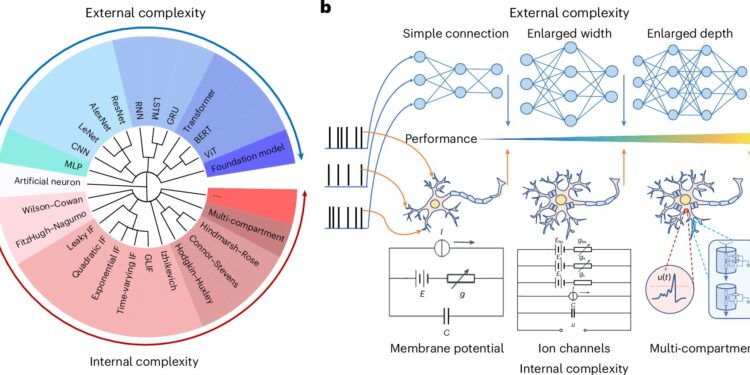The internal and external complexity of neurons and networks. Credit: Nature Computer Science (2024). DOI: 10.1038/s43588-024-00674-9
A team of Chinese scientists has established a new brain-inspired network model based on internal complexity to address challenges faced by traditional models, such as high consumption of computing resources, according to the Institute of Automation of the Chinese Academy of Sciences.
The study is published in the journal Nature Computer Science.
One of the main goals of current artificial intelligence (AI) development is to create more versatile AI, allowing models to possess broader and more general cognitive capability.
The current popular approach used by large models is to build larger, deeper and wider neural networks based on scaling law, which can be regarded as a method to achieve general intelligence based on “external complexity,” said Li Guoqi, a researcher at the Institute of Automation.
However, this approach faces challenges such as unsustainable consumption of computing resources and energy, as well as a lack of interpretability.
The human brain has about 100 billion neurons and nearly a billion synaptic connections, with each neuron having a rich and diverse internal structure. But the energy consumption of a human brain is only about 20 watts.
Inspired by the dynamics of brain neurons, scientists at the Institute of Automation and other research institutions such as Tsinghua University and Peking University have used an “internal complexity” approach to achieve general intelligence.
Their experiments verified the effectiveness and reliability of the internal complexity model in handling complex tasks, providing new methods and theoretical support for integrating the dynamic characteristics of neuroscience into AI, and also offering feasible solutions for optimizing and improving the practical performance of AI models.
More information:
Linxuan He et al, A network model with internal complexity links artificial intelligence and neuroscience, Nature Computer Science (2024). DOI: 10.1038/s43588-024-00674-9
Provided by Chinese Academy of Sciences
Quote: Scientists Build Brain-Inspired Network Model to Connect AI, Neuroscience (2024, August 21) retrieved August 21, 2024 from
This document is subject to copyright. Apart from any fair dealing for the purpose of private study or research, no part may be reproduced without written permission. The content is provided for informational purposes only.



